Bulk-generate & schedule posts in seconds with Smart Scheduling. Try now!
Audience engagement: A complete guide to strategies and examples
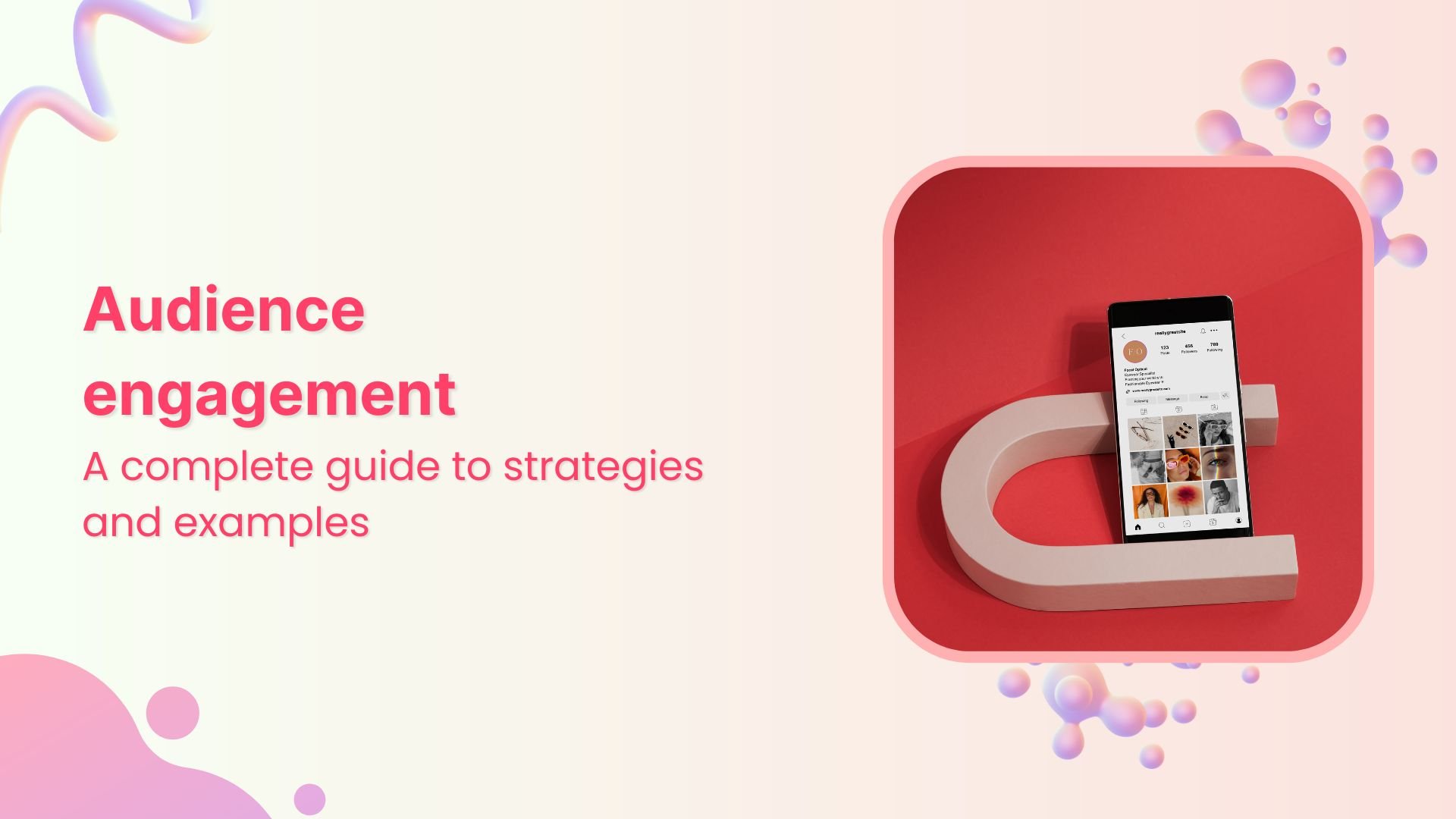
With so much competition on social media, capturing and maintaining audience engagement has become difficult but also one of the most important aspects of successful marketing strategies. Millions of social media posts compete for attention across various platforms, so brands must know how to build lasting relationships with their audiences.
This comprehensive guide explores proven strategies, practical examples, and actionable insights to help you transform passive viewers into active, engaged social media community members.
What is audience engagement?
Audience engagement refers to the level of interaction, participation, and emotional connection between a brand and its audience across various digital touchpoints. It includes all the ways people actively respond to, interact with, and participate in your content rather than simply consuming it passively.
Key characteristics of audience engagement
- Active participation: Users comment, share, and create responses to your content.
- Emotional connection: Audiences develop feelings of trust, loyalty, or enthusiasm toward your brand.
- Consistent interaction: Regular engagement patterns rather than one-time interactions.
- Value exchange: Both parties benefit from the interaction experience.
- Community building: Connections form between audience members around your brand.
True audience engagement goes beyond surface-level metrics like views or impressions. When audiences are truly engaged, they become active participants in conversations, advocates for your brand, and valuable sources of feedback and user-generated content.
The most successful brands focus on building genuine relationships rather than simply engaging the audience.
Also Read: Social media engagement: 14 easy ways to improve it
Types of audience engagement
Understanding the different types of audience engagement can help you recognize opportunities for deeper connection and measure your success more effectively.
1. Likes and reactions
The most basic form of engagement involves simple interactions like likes, hearts, thumbs up, or platform-specific reactions. While these may seem minimal, they represent acknowledgment and approval from your audience.
Platform-specific reactions include:
- Facebook’s six reaction options (Like, Love, Care, Haha, Wow, Sad, and Angry, etc.).
- LinkedIn’s professional reactions (Like, Celebrate, Support, Love, Insightful, and Funny).
- X / Twitter’s heart and retweet options.
- Instagram’s heart reactions on posts and Stories.
- YouTube’s thumbs-up and thumbs-down system.
2. Comments and replies
Comments represent a higher level of engagement investment, as they require audiences to actively formulate thoughts and responses. Quality comments often spark meaningful conversations, while replies to comments demonstrate ongoing dialogue.
High-value comment types include:
- Detailed questions about products or services.
- Personal experiences related to your content.
- Constructive feedback and suggestions.
- Answers to other users’ questions.
- Thoughtful discussions about industry topics.
3. Shares and resharing
When someone shares your content, they’re essentially endorsing it to their own network, significantly amplifying your reach. This type of engagement indicates strong content resonance and trust in your brand.
Sharing behaviors across platforms:
- Instagram Story reshares and post shares to Stories.
- Facebook shares with personal commentary.
- Twitter retweets with added thoughts.
- LinkedIn shares professional insights.
- TikTok reposts and video responses.
Also Read: How to create shareable content in 2025?
4. Direct messages
Private interactions through direct messages indicate high interest and often represent serious inquiries about products, services, or collaborations. These personal touchpoints offer opportunities for individualized relationship building and can lead to conversions more directly than public interactions.
5. Reviews and mentions
User reviews, testimonials, and organic mentions across platforms represent authentic audience validation. These forms of engagement carry significant weight with potential customers and provide credible social proof for your brand’s value proposition.
6. Website interaction
Engagement extends beyond social platforms to include website behaviors like newsletter subscriptions, download requests, form submissions, and extended page visits. These actions often indicate stronger purchase intent and deeper interest in your offerings.
7. Subscription sign-ups
Email subscriptions, social media follows, and platform-specific subscriptions represent long-term engagement commitments. These audiences have expressed interest in ongoing relationships with your brand and typically show higher lifetime value.
Why is audience engagement important?
Understanding the strategic value of digital audience engagement helps justify investment in comprehensive engagement tactics and demonstrates the business impact of community-building efforts.
1. Build brand loyalty
Engaged audiences develop emotional connections with brands that transcend transactional relationships. When customers feel heard, valued, and connected to your brand’s story, they become loyal advocates who choose your products repeatedly and recommend them to others.
The benefits of strong brand loyalty include:
- Reduced customer acquisition costs.
- Increased customer lifetime value.
- Higher retention rates.
- Positive word-of-mouth and viral marketing.
- Premium pricing tolerance.
- Resistance to competitor offers.
2. Increase brand visibility
Social media algorithms prioritize content that generates engagement, meaning highly interactive posts reach larger audiences organically. Each comment, share, and reaction signals to algorithms that your content provides value, resulting in expanded reach without additional advertising spend.
The algorithmic benefits of high engagement are:
- Improved organic reach across platforms.
- Higher placement in news feeds.
- Increased visibility in the explore sections.
- Better performance in search results.
- Enhanced recommendation algorithm favorability.
3. Collect feedback
Engaged audiences provide invaluable insights through their interactions, comments, and behaviors. This feedback helps refine products, improve services, and create content that better meets audience needs.
Some of the key types of valuable audience feedback are:
- Product improvement suggestions.
- Content topic requests.
- User experience insights.
- Market trend observations.
- Competitive intelligence.
- Customer service improvement opportunities.
4. Improve user experience
Engagement interactions highlight what resonates with your audience and what doesn’t, enabling continuous optimization of your content strategy, posting schedule, and platform approach. Understanding audience preferences helps create more satisfying experiences that encourage continued interaction.
5. Maximize customer retention
Engaged customers are significantly more likely to remain loyal to brands over time. Regular interaction creates habitual consumption patterns and emotional investment that make switching to competitors less appealing.
Some of the most important customer retention statistics are:
- Engaged customers have 23% higher lifetime value.
- 71% of consumers are more likely to recommend brands they feel connected to.
- Engaged customers spend 40% more annually than non-engaged customers.
- Customer retention costs 5-25 times less than acquisition.
How to engage an audience?
Now that you are familiar with the importance of audience engagement, let’s learn how to engage your audience through some tried-and-tested strategies. Successful digital audience engagement requires strategic planning, consistent execution, and continuous optimization based on audience response and platform evolution.

Know your target audience
Deep audience understanding forms the foundation of effective engagement strategies. Analyze your audience demographics, behavioral patterns, content preferences, and communication styles to create detailed audience personas. You can use the following methods to conduct audience research:
- Social media analytics review.
- Customer surveys and interviews.
- Website behavior analysis.
- Competitor audience analysis.
- Social listening insights.
- Direct feedback collection.
Moreover, understanding when your audience is most active helps optimize your posting schedule for maximum engagement, while knowing their content preferences guides your creative strategy.
Also Read: 15 strategies to identify and engage your social media target audience
Use AI and social listening
Modern engagement tactics benefit significantly from artificial intelligence tools and social listening platforms that monitor conversations about your brand, industry, and competitors. You can enjoy the following benefits by using AI to engage your audience:
- Optimal posting time predictions.
- Content topic suggestions based on trends.
- Automated response capabilities for common inquiries.
- Sentiment analysis for brand monitoring.
- Influencer identification and outreach opportunities.
- Predictive analytics for engagement optimization.
Adopt high-performing content types and formats
Different content formats generate varying levels of engagement across platforms. Understanding what works best for your audience and each platform helps maximize interaction potential.
The following table summarizes the high-engagement content format across popular platforms:
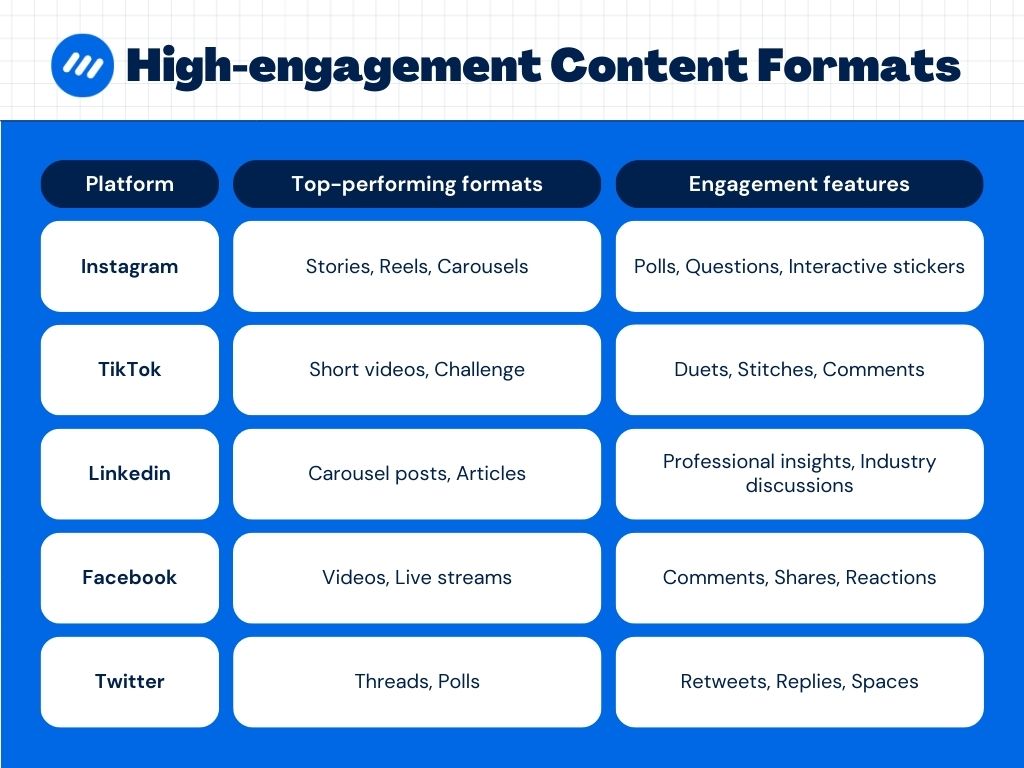
Create an engaging content strategy
Develop a content strategy that balances educational, entertaining, and promotional content while maintaining a consistent brand voice and values.
Your content strategy framework should be something like this:
- 70% Educational content: Tutorials, tips, industry insights.
- 20% Entertainment content: Fun facts, memes, lighthearted posts.
- 10% Promotional content: Product features, sales, company news.
Successful brands understand that engaging an audience involves creating engaging content while maintaining authenticity throughout all interactions to engage your audience.
Experience organized workflow with a unified social media management platform for agencies.
Try ContentStudio for FREE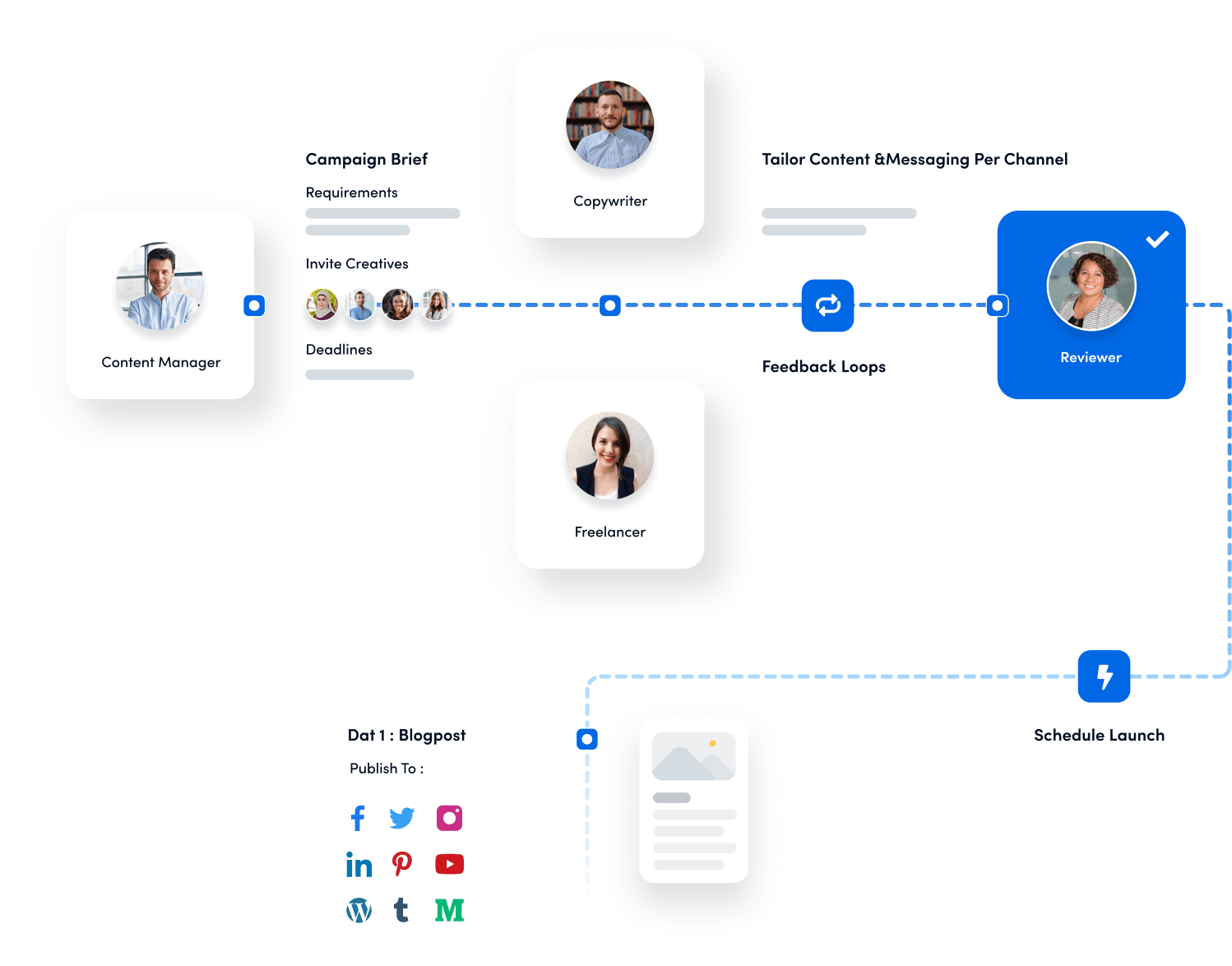
Measuring audience engagement
Measuring your audience engagement is important to get insights needed to optimize engagement strategies and demonstrate business impact to stakeholders.
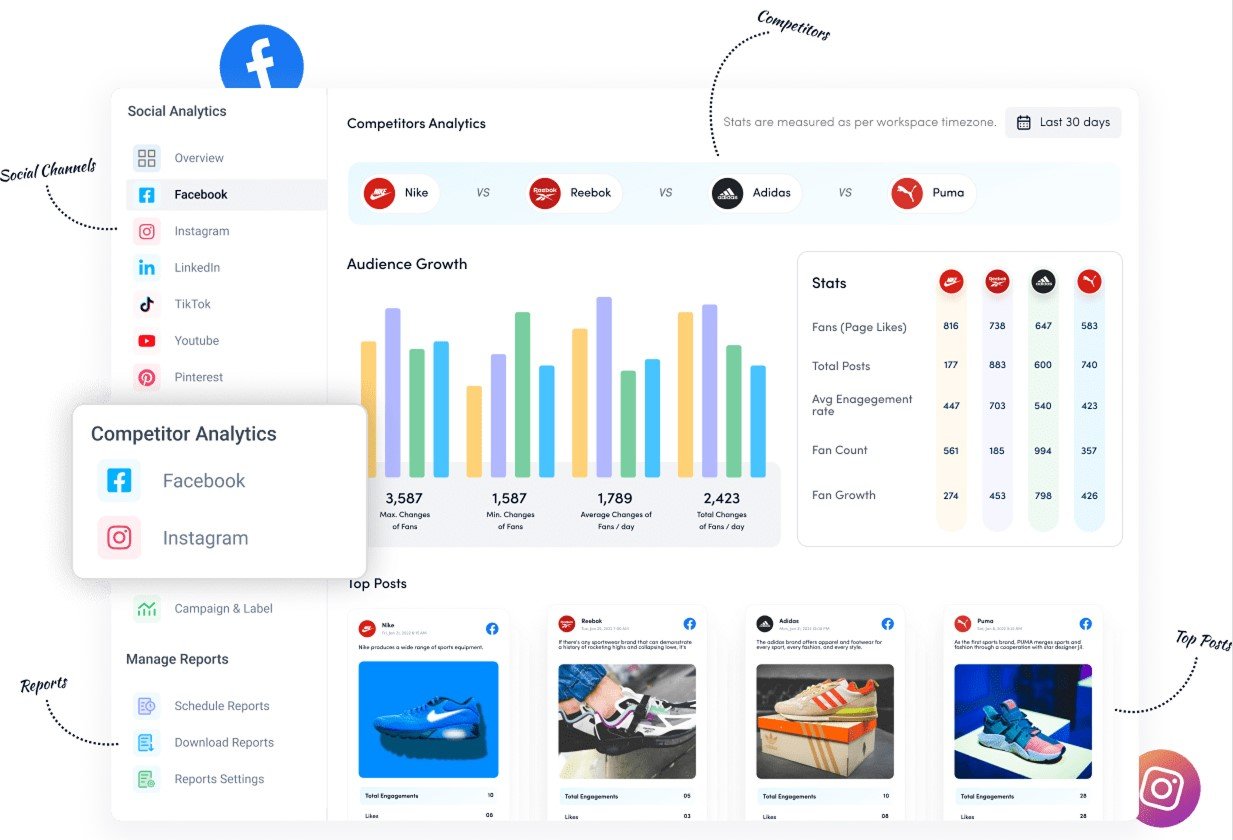
Here are the three steps involved in measuring audience engagement:
Step 1: Define the metrics
Establish clear key performance indicators that align with your business objectives and provide actionable insights for strategy improvement.
Primary engagement metrics
- Likes: Basic approval indicators that show content resonance.
- Comments: High-value interactions requiring active thought and response.
- Shares: Endorsement behaviors that amplify reach through user networks.
- Video views: Content consumption depth and audience attention capture.
- Click-through rate (CTR): Users who click links to visit your website or landing pages.
- Followers: Long-term engagement commitments and community growth indicators.
- Time on page: Website engagement depth showing content value and interest.
- Conversion rates: Ultimate engagement success measuring business impact.
- Completion rates: Percentage of users who view entire videos or content pieces.
- Engagement rate: Total interactions divided by reach or impressions for overall performance.
- Comment sentiment: Positive, neutral, or negative comment analysis for relationship quality.
- Save rate: Users who save content for later reference, indicating high perceived value.
- Response time: How quickly you respond to audience interactions.
Secondary engagement metrics
- User-generated content mentions: Organic brand references.
- Hashtag usage: Community adoption of branded hashtags.
- Story completion rates: Percentage who view entire Stories.
- Video completion rates: How much of the videos audiences watch.
- Direct message volume: Private interaction frequency.
Also Read: 20 social media KPIs you need to track to measure success
Step 2: Use the right tracking and analytics tools
Utilize comprehensive analytics platforms that provide detailed engagement insights across multiple channels.
Essential analytics tool categories:
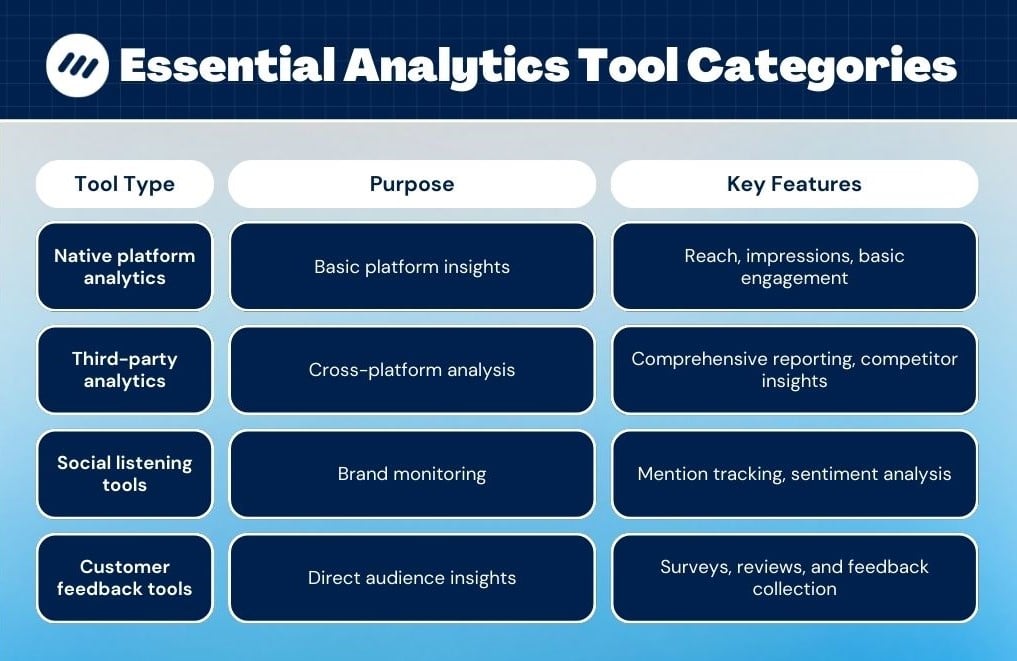
Top analytics platforms for engagement tracking
- ContentStudio.io’s comprehensive analytics dashboard.
- Platform-native analytics (Instagram Insights, Facebook Analytics).
- Google Analytics for website engagement tracking.
- Social listening tools for mention and sentiment monitoring.
- Survey platforms for direct feedback collection.
Step 3: Analyze and understand the engagement data
Regular analysis of engagement data reveals patterns that inform strategic decisions and optimization opportunities. You should focus on these areas while analyzing the data:
- Content performance patterns: Which topics, formats, and styles generate the highest engagement.
- Timing optimization: When your audience is most active and responsive.
- Platform effectiveness: Which channels drive the most valuable engagement.
- Audience segment preferences: How different groups respond to various content types.
- Competitive benchmarking: How your engagement compares to industry standards.
Monthly engagement analysis checklist
- Review top-performing content and identify success factors.
- Analyze low-engagement content for improvement opportunities.
- Track engagement rate, trends, and seasonal patterns.
- Assess response time performance and community management effectiveness.
- Evaluate goal progress and adjust strategies accordingly.
- Identify emerging engagement opportunities and platform features.
How to increase audience engagement?
Learning how to keep your audience engaged requires systematic implementation of proven tactics combined with creative experimentation tailored to your specific audience and industry.
Some of the key strategies to increase digital audience engagement are:
Create content around relevant trends
Stay current with industry trends, cultural moments, and platform-specific features to create timely, relevant content. You can keep up with the latest trends through the following ways:
- Analyze trending hashtags across platforms.
- Follow industry thought leaders and publications.
- Use social listening tools for emerging topic detection.
- Track competitor content performance.
- Analyze viral content in your niche.
- Subscribe to trend forecasting resources.
Build community connections
Building community connections is also an effective way to increase audience engagement. You should focus on fostering genuine relationships by responding promptly to comments, acknowledging user contributions, and creating opportunities for audience members to connect with each other.
Community building tactics
- Respond within 2-4 hours to comments and messages when possible.
- Use personal names when addressing community members.
- Ask follow-up questions to extend conversations.
- Feature community members in your content regularly.
- Create hashtags that encourage community participation.
- Host virtual events that bring audiences together.
Use interactive elements
You should incorporate features that require active participation rather than passive consumption to increase audience engagement.
Every social media platform has its own variety of interactive elements. The following table summarizes these high-engagement interactive elements:
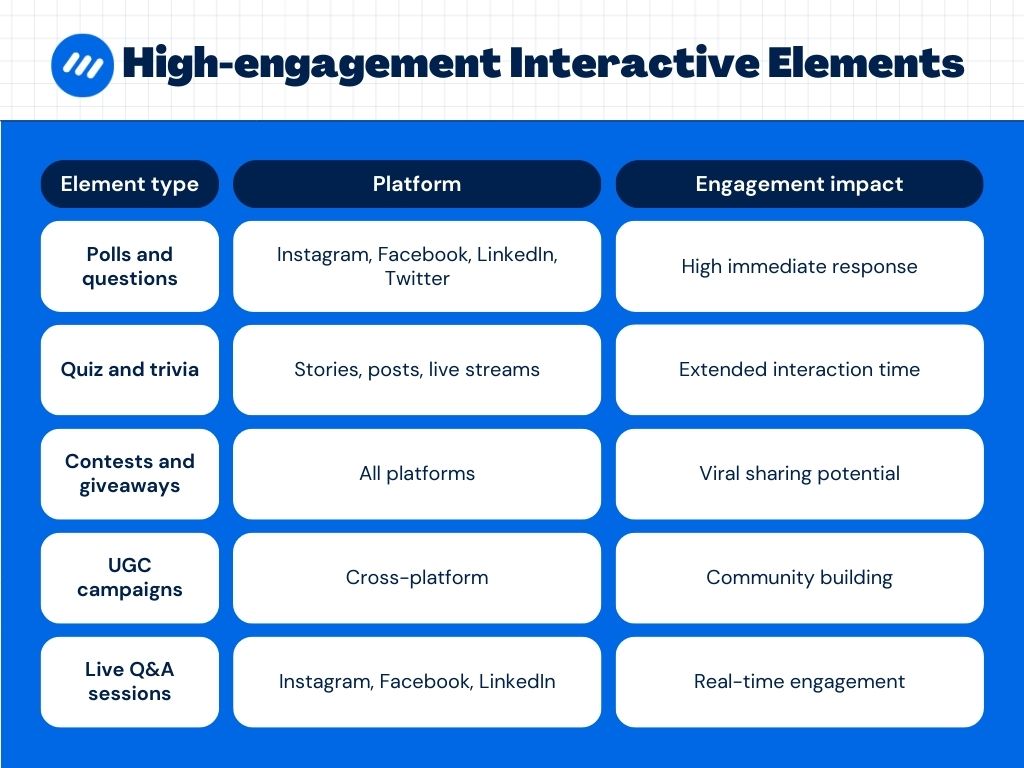
Also Read: Top 15 ideas for fun Instagram story games
Best audience engagement strategies
Let’s discuss the top 8 audience engagement tactics and tips in detail:
Strategy # 1: Build a brand identity
Develop a distinctive brand personality that audiences can easily recognize and connect with across all touchpoints. The key components of an effective brand identity are:
- Visual consistency: Recognizable color schemes, fonts, and design elements.
- Voice and tone: Consistent communication style across all content.
- Values alignment: Clear stance on issues important to your audience.
- Personality traits: Distinct characteristics that humanize your brand.
- Unique perspective: Differentiated viewpoint on industry topics.
Also Read: Unlocking the power of brand identity: An expert guide
Strategy # 2: Use visual storytelling
Visual content consistently outperforms text-only posts across all platforms. Develop a cohesive visual style that supports your brand identity while creating emotionally compelling narratives.

The key elements to consider are:
- High-quality and engaging images that support your message.
- Consistent filter and editing style.
- Brand-aligned color palette.
- Strategic use of graphics and text overlays.
- Video content that tells complete stories.
- User-generated visual content integration.
Strategy # 3: Share personalized content
Customize content to specific audience segments based on their interests, behaviors, and engagement history. You can easily personalize the content by using these strategies:
- Segment your audience by demographics, interests, and behavior patterns.
- Create content variations for different audience groups.
- Use audience insights to inform content topics and timing.
- Reference past interactions when responding to community members.
- Customize calls-to-action based on audience segment goals.
- Adapt content formats to segment preferences.
Strategy # 4: Be responsive
Timely responses to comments, messages, and mentions demonstrate that you value audience input and are genuinely interested in building long-term relationships, instead of just engaging the audience for a short time.
A general response strategy framework you can follow is:
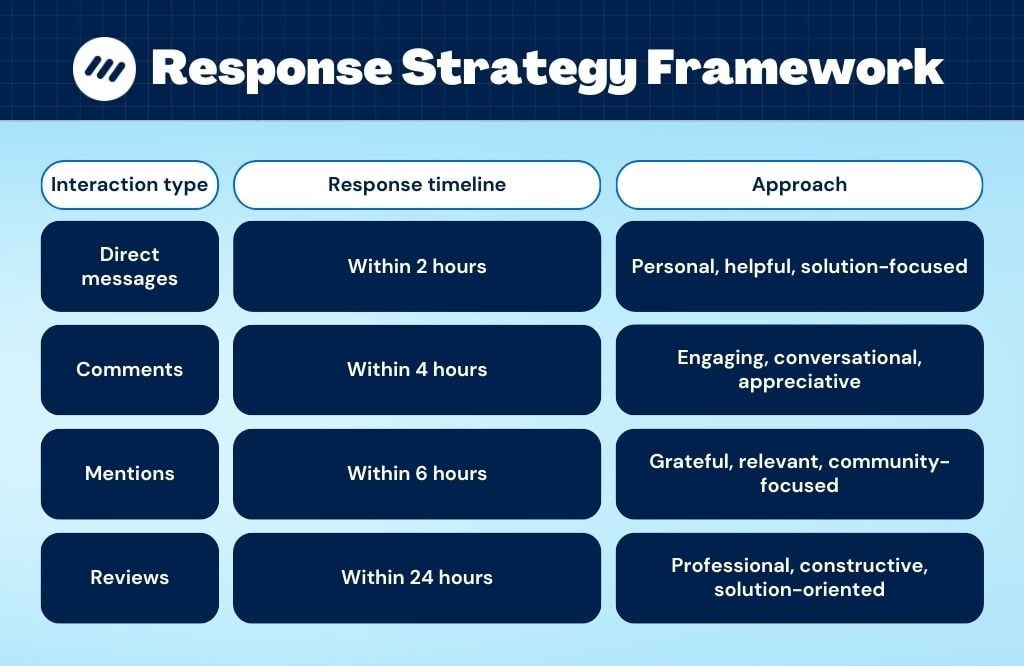
Response best practices
- Acknowledge every interaction, even with simple thanks.
- Ask follow-up questions to extend conversations.
- Provide helpful information and resources.
- Maintain brand voice consistency across all responses.
- Address concerns publicly when appropriate for transparency.
Managing multiple social media conversations efficiently requires tools like ContentStudio’s social inbox, which centralizes all interactions for streamlined response management.
Strategy # 5: Use user-generated content
Encourage and showcase content created by your audience to build community investment and provide authentic social proof.

User-generated content campaign types:
- Photo contests with branded hashtags.
- Video testimonials from satisfied customers.
- Product reviews and unboxing experiences.
- Creative challenges that showcase brand creativity.
- Community spotlights featuring customer stories.
- Collaborative content where users contribute ideas or materials.
UGC campaign implementation:
- Define clear campaign goals and success metrics.
- Create compelling hashtags and participation guidelines.
- Offer attractive incentives for participation.
- Promote campaigns across all marketing channels.
- Feature submitted content prominently.
- Always credit original creators appropriately.
Strategy # 6: Invite influencer collaborations
Partner with influencers whose audiences align with your target demographics to expand reach and credibility.
Influencer collaboration types
- Nano-influencers (1K-10K followers) for authentic niche engagement.
- Micro-influencers (10K-100K followers) for targeted reach.
- Macro-influencers (100K-1M followers) for broader awareness.
- Mega-influencers (1M+ followers) for maximum exposure.
Collaboration format options:
- Sponsored posts featuring your products or services.
- Instagram takeovers showcasing brand personality.
- Co-created content that benefits both audiences.
- Product reviews and authentic recommendations.
- Event partnerships and joint promotions.
Strategy # 7: Experiment with formats
Regular experimentation with new content formats, platform features, and engagement tactics prevents staleness and keeps audiences interested.
Content format experimentation areas
- Video length variations – Short clips vs. longer explanatory content.
- Post timing tests – Different days and times for optimal engagement.
- Content type rotation – Educational, entertaining, promotional mix.
- Interactive feature adoption – New platform features and tools.
- Cross-platform content adaptation – Tailoring content for each platform.
- Community content integration – Featuring audience contributions.
A/B testing framework
- Identify specific variables to test.
- Create control and variation content versions.
- Monitor engagement differences over consistent time periods.
- Analyze results for statistical significance.
- Implement successful variations into the regular strategy.
- Document findings for future reference.
Understanding what makes content engaging helps guide experimentation efforts toward formats most likely to succeed with your audience.
Strategy # 8: Evaluate strategy
Regular assessment of engagement performance against established goals enables continuous improvement and strategy refinement. You can evaluate your strategy as per the following frequency:
- Weekly – Quick performance review and immediate adjustments.
- Monthly – Comprehensive analysis and strategy tweaks.
- Quarterly – Major strategy assessment and goal realignment.
- Annually – Complete strategy overhaul and goal setting.
Key evaluation questions:
- Which content types generate the highest quality engagement?
- What topics resonate most strongly with our audience?
- How does our engagement compare to industry benchmarks?
- Which platforms provide the best engagement ROI?
- What audience feedback patterns emerge from interactions?
- How can we improve response times and interaction quality?
Audience engagement examples
Let’s discuss the real-world examples of digital audience engagement to see how different engagement strategies work across various industries and platforms.
1. Live streams and webinars
Live content creates urgency and exclusivity that drives real-time engagement and fosters immediate community connection.
Successful live content formats
- Product demonstrations showing features and benefits interactively.
- Behind-the-scenes tours of offices, events, or production processes.
- Expert interviews featuring industry leaders and thought leaders.
- Community Q&A sessions addressing audience questions directly.
- Event coverage brings audiences into exclusive experiences.
- Educational webinars with Q&A segments for real-time learning.

2. Social media activity
Strategic social media presence across multiple platforms creates numerous touchpoints for audience interaction and relationship building.
Here are some effective platform-specific digital audience engagement tactics:
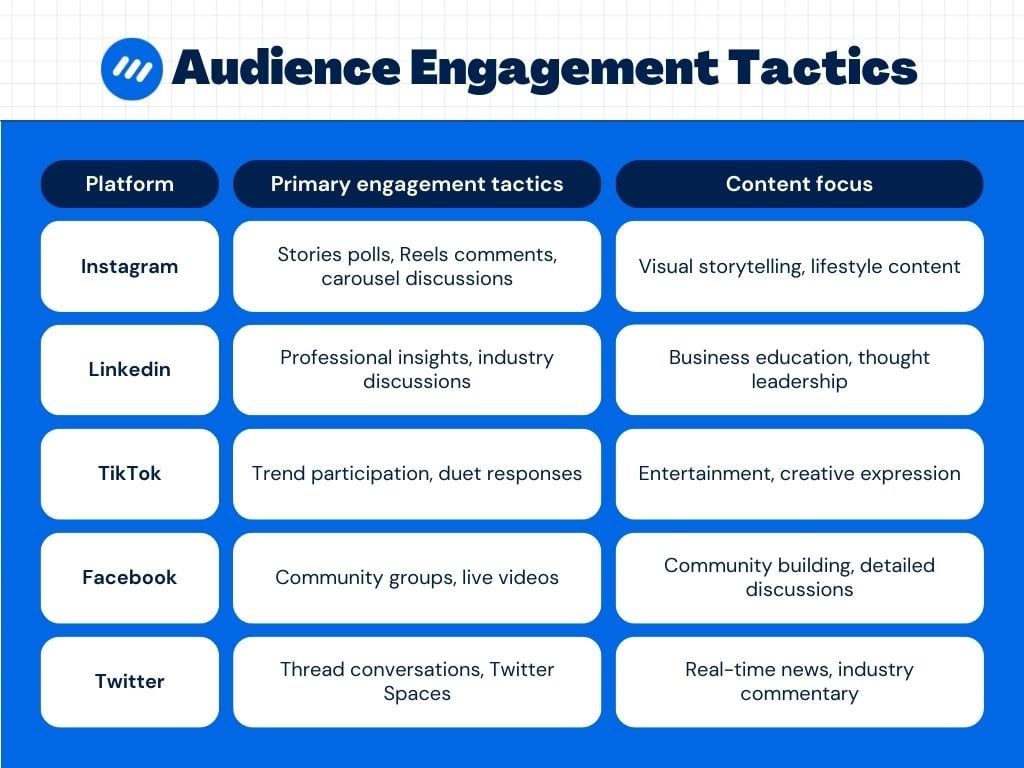
Cross-platform engagement best practices
- Adapt content for each platform’s unique culture and audience expectations.
- Maintain a consistent brand voice while adjusting tone for platform norms.
- Use platform-specific features to maximize engagement potential.
- Create platform-exclusive content to reward followers on each channel.
- Cross-promote content strategically without overwhelming audiences.
3. Online reviews and ratings
Customer review platforms provide opportunities for ongoing engagement through responses to feedback, addressing concerns, and highlighting positive experiences.
Review engagement strategies
- Respond to all reviews, that means both positive and negative feedback.
- Thank positive reviewers and encourage future engagement.
- Address negative feedback professionally and offer solutions.
- Use reviews as content for social media and marketing materials.
- Encourage satisfied customers to leave reviews through follow-up communications.
- Monitor review trends for product and service improvement insights.

4. Live events and meetings
In-person and virtual events create intensive engagement opportunities through presentations, networking, workshops, and one-on-one interactions.
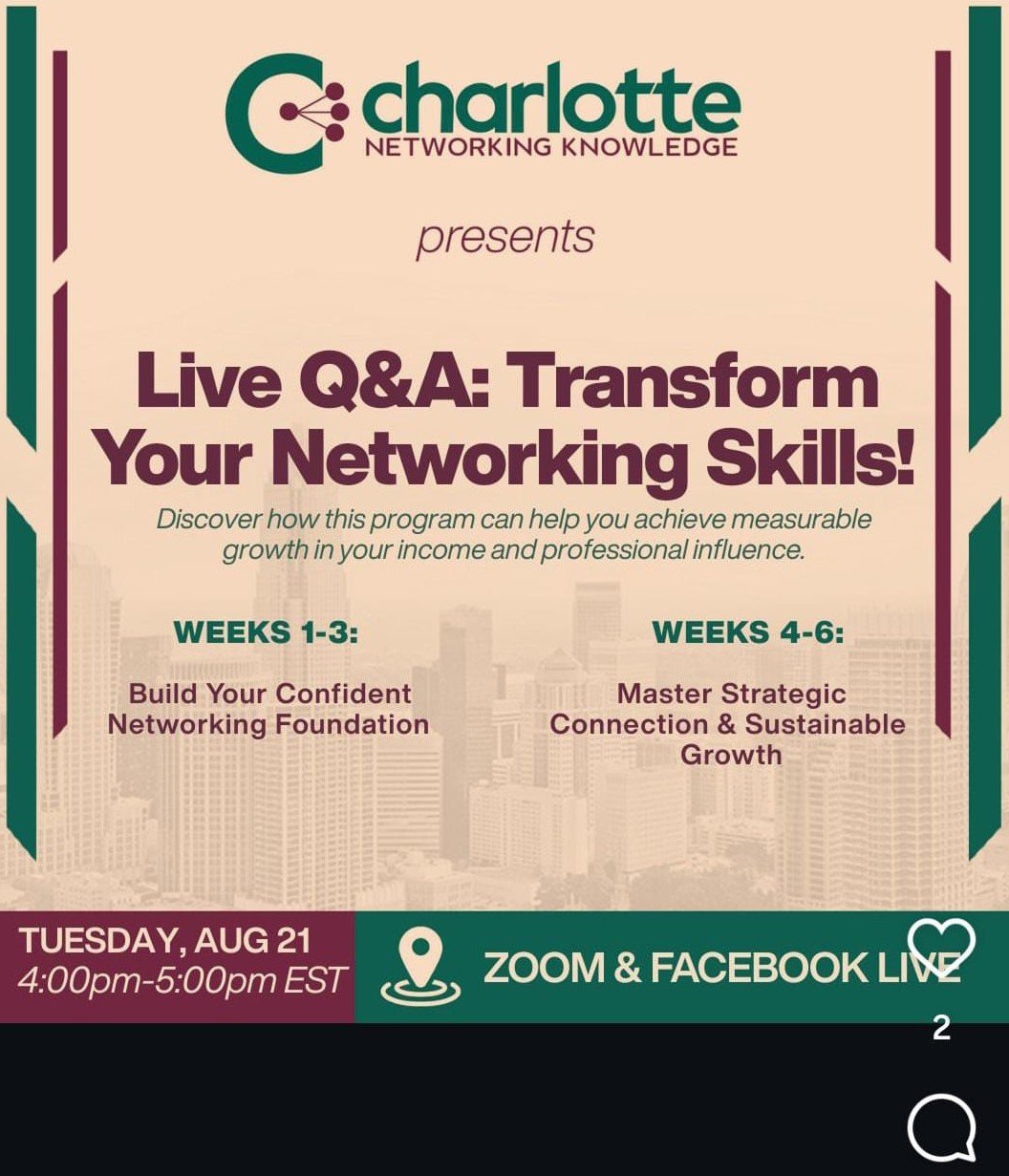
Event engagement optimization
- Pre-event promotion builds anticipation and attendance.
- Live social media coverage extends reach beyond attendees.
- Interactive elements like Q&A sessions and polls during presentations.
- Networking facilitation through structured interaction opportunities.
- Post-event follow-up maintains engagement momentum.
- Content creation from event highlights for ongoing engagement.
5. Surveys and questionnaires
Direct feedback collection through surveys and questionnaires is useful in engaging the audience by soliciting their opinions and demonstrating that their input influences business decisions.
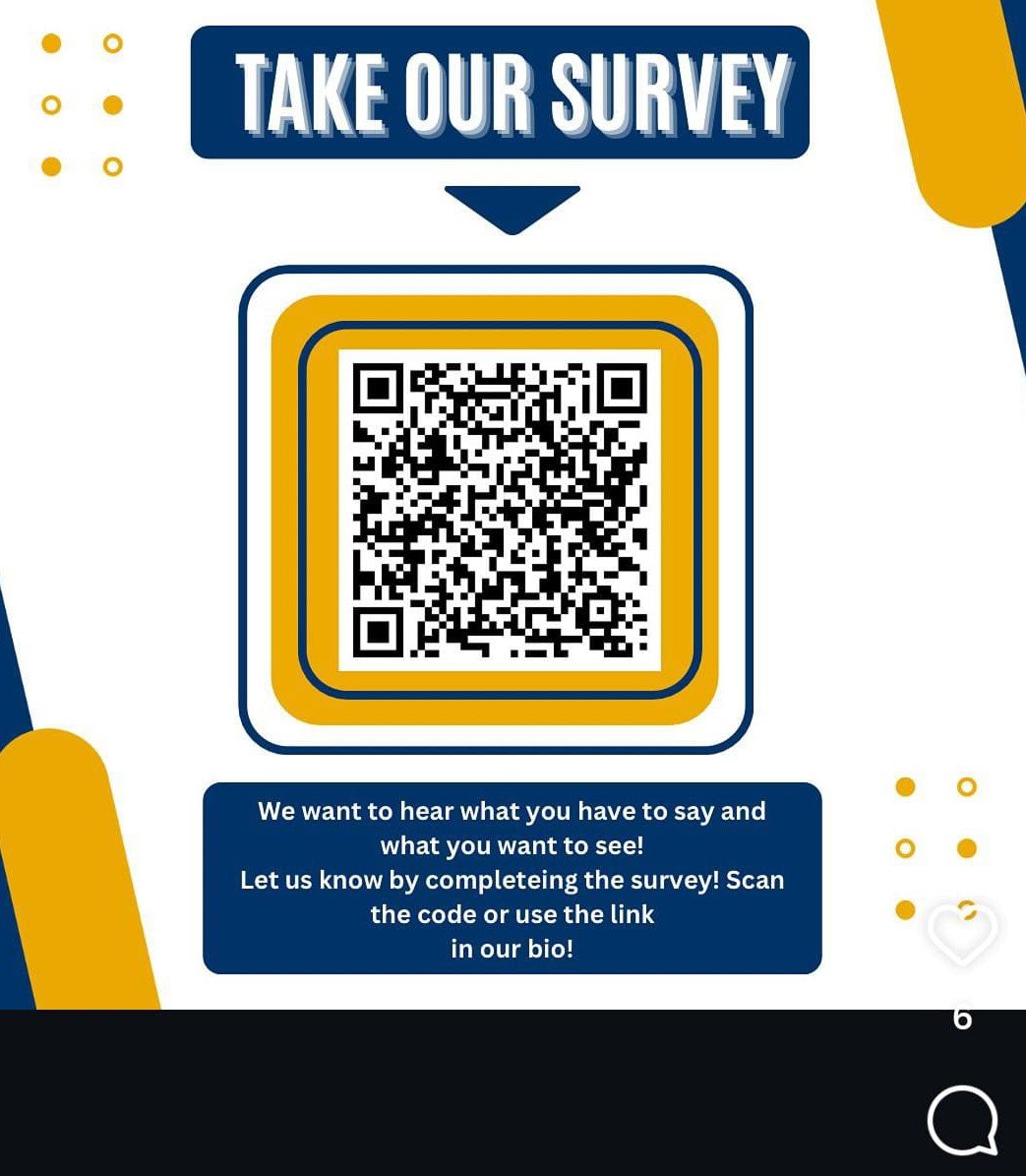
Survey engagement best practices
- Keep surveys short – 5-10 questions maximum for higher completion rates.
- Ask relevant questions that provide actionable insights.
- Offer incentives for participation when appropriate.
- Share results with the community to demonstrate transparency.
- Act on feedback and communicate changes made based on input.
- Use interactive formats like Instagram polls for quick feedback.
Conclusion
Audience engagement represents the bridge between content creation and business results, transforming passive viewers into active community members and eventual customers. Success requires strategic planning, consistent execution, and continuous optimization based on audience feedback and performance data.
Key takeaways for engagement success
- Focus on building genuine relationships rather than chasing vanity metrics.
- Understand your audience deeply and create content that serves their needs.
- Use data and analytics to guide strategy decisions and optimizations.
- Experiment with different formats and tactics to discover what works best.
- Maintain consistency in brand voice and value delivery across all interactions.
- Invest in community building and relationship development for long-term success.
Try ContentStudio today if you’re ready to transform your audience engagement strategy, streamline your social media engagement efforts, track performance across multiple platforms, and build stronger relationships with your audience.
FAQs
What is audience engagement?
Audience engagement is the level of interaction, participation, and emotional connection between a brand and its audience across digital platforms. It includes all forms of active response to content, from basic likes and shares to detailed comments, direct messages, and user-generated content creation. True engagement represents genuine interest and investment from audiences in your brand’s message and offerings.
How do you measure audience engagement?
Measure audience engagement through metrics like engagement rate (total interactions divided by reach), comment quality and sentiment, share rates, click-through rates, and conversion rates from engaged audiences. Use analytics tools to track these metrics consistently and analyze trends over time to optimize your strategy. Focus on quality indicators like comment length and sentiment rather than just interaction volume.
What are the best types of content for audience engagement?
The most engaging content types include interactive elements like polls and questions, behind-the-scenes content, user-generated content features, educational tutorials, live videos, and authentic storytelling.
What’s the difference between reach and engagement?
Reach measures how many people see your content, while engagement measures how many people interact with it. Engagement is generally more valuable as it indicates genuine interest and connection rather than passive exposure.
How often should I post to maintain audience engagement?
Posting frequency should balance consistency with quality, varying by platform and audience preferences. Focus on maintaining regular posting schedules rather than specific frequency numbers.
Recommended for you
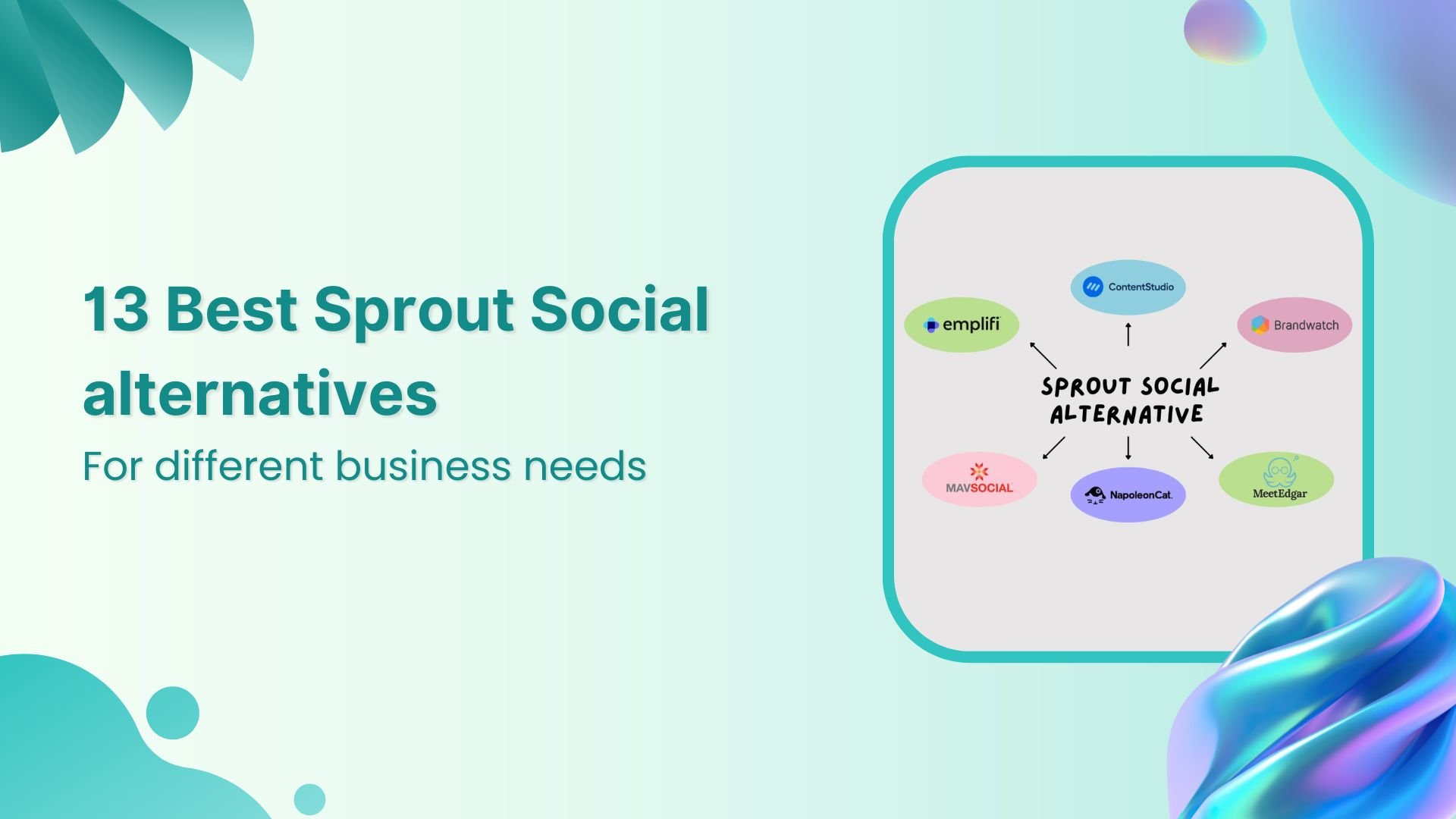
13 Best Sprout Social alternatives for effective social media management

150+ Black Friday quotes, hashtags, and slogans to boost sales
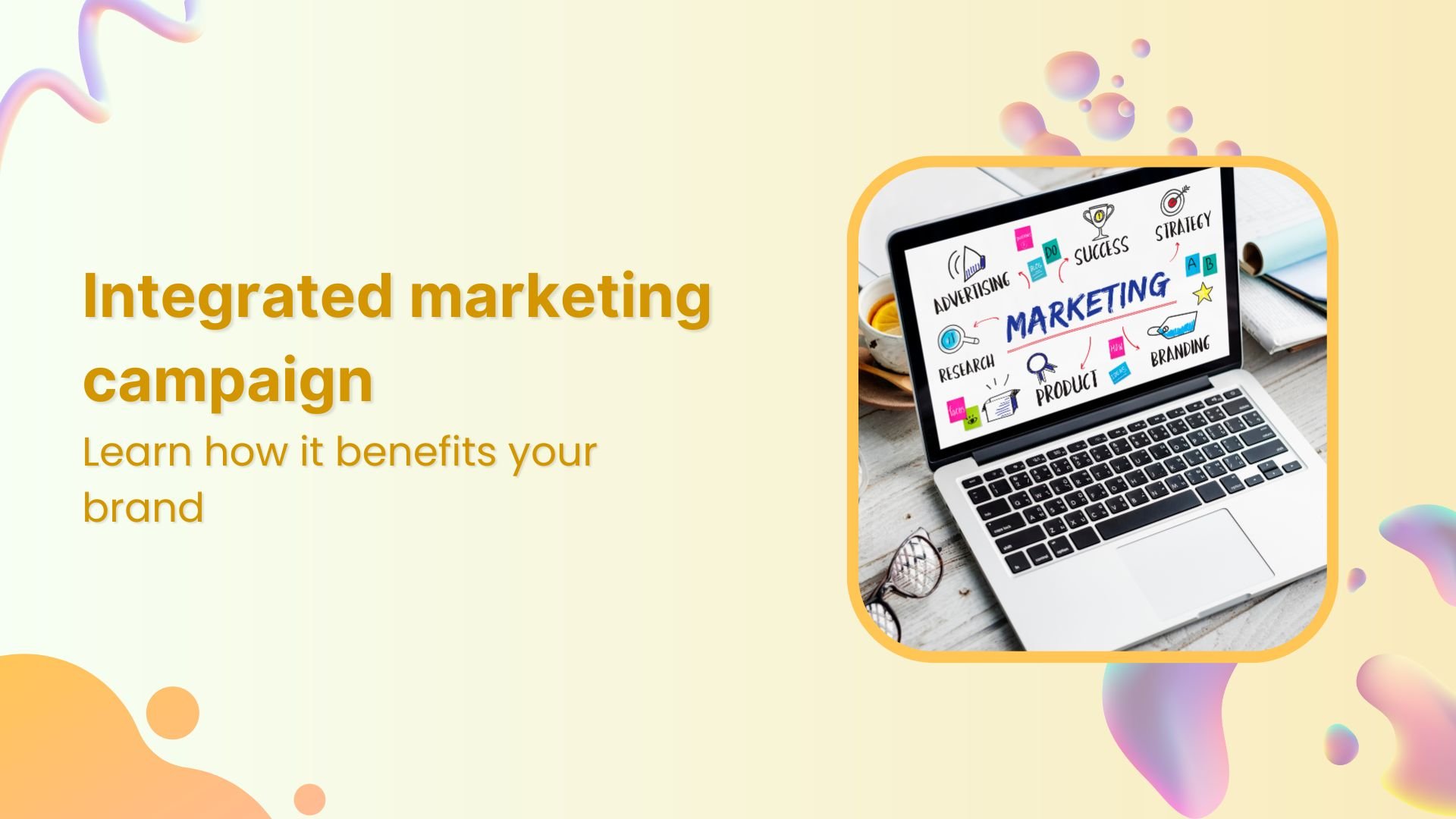
Why is an integrated marketing campaign beneficial for your brand?


Powerful social media management software
14-day free trial - No credit card required.
